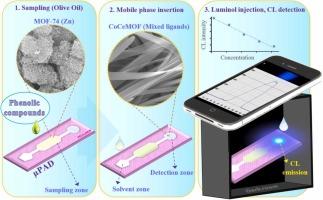Fully integrated microfluidic paper-based analytical device for straightforward extraction and estimation of the total phenolic content of olive oil samples
IF 8
1区 化学
Q1 CHEMISTRY, ANALYTICAL
引用次数: 0
Abstract
The work presents an innovative, fully integrated microfluidic paper-based analytical device (μPAD), designed for the straightforward analysis of phenolic compounds (PCs) in olive oil. The device exploits metal-organic frameworks (MOFs) to successively extract and measure the analytes, enabling a sample-in-answer-out analysis. The sampling zone was modified with a zinc-based MOF (MOF-74(Zn)) to retain the oil, effectively. Subsequently, a mobile phase was used to direct PCs to the chemiluminescence (CL) detection zone, where a new bimetal MOF (Co0.8Ce0.2-BTC0.9PyDC0.1, BTC=1,3,5-benzene dicarboxylate, PyDC=pyridine-3,5-dicarboxylate) was utilized as an oxidase super-mimic. Inserting a second cation and using the mixed ligands caused lots of open metal and electron-rich sites in the structure of MOF and resulted in its potent oxidase-like activity, enormously amplifying the emission of luminol. The detection of PCs also relies on their decreasing effect on CL intensity. The extraction and detection processes underwent thorough optimization, and the performance characteristics were carefully assessed. The μPAD demonstrated sensitive and specific detection of PCs within the concentration range of 2–500 µg mL−1, with appropriate precision (RSD < 6 %). The detection limits were in the range of 1.02–1.26 µg mL−1. The method requires negligible sample treatment, and a simple operation, offering a simple yet powerful alternative to non-portable and sophisticated detection systems. The presented device holds potential applications for screening purposes, paving the way for future advancements in this field.

求助全文
约1分钟内获得全文
求助全文
来源期刊

Sensors and Actuators B: Chemical
工程技术-电化学
CiteScore
14.60
自引率
11.90%
发文量
1776
审稿时长
3.2 months
期刊介绍:
Sensors & Actuators, B: Chemical is an international journal focused on the research and development of chemical transducers. It covers chemical sensors and biosensors, chemical actuators, and analytical microsystems. The journal is interdisciplinary, aiming to publish original works showcasing substantial advancements beyond the current state of the art in these fields, with practical applicability to solving meaningful analytical problems. Review articles are accepted by invitation from an Editor of the journal.
 求助内容:
求助内容: 应助结果提醒方式:
应助结果提醒方式:


